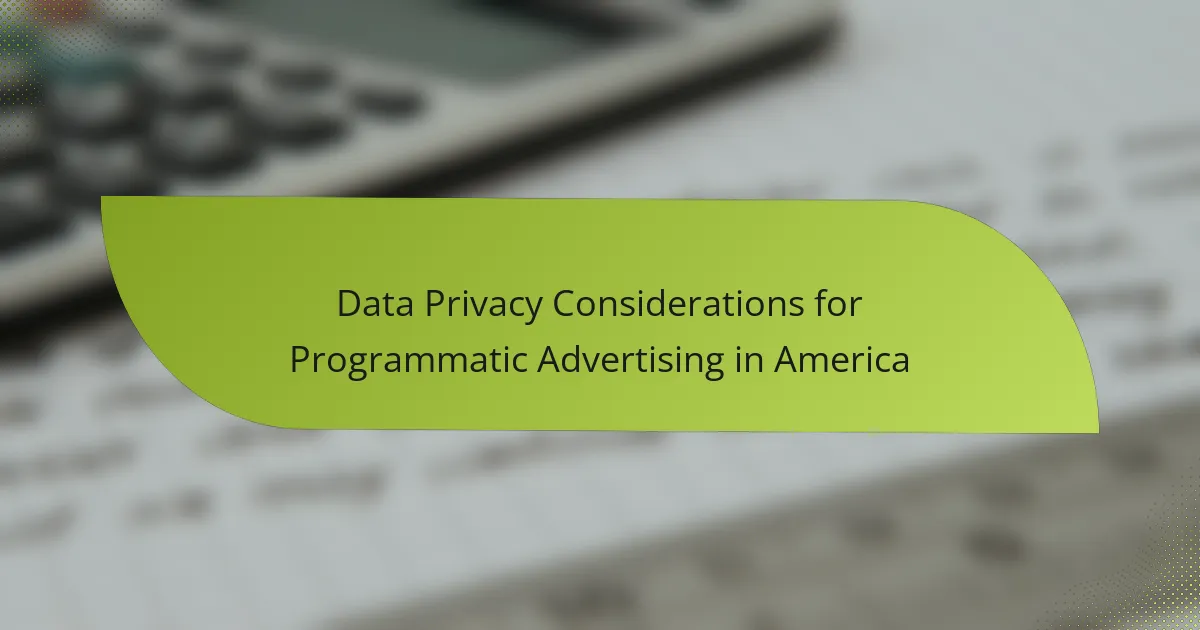In the competitive landscape of programmatic advertising in the United States, effective targeting strategies are essential for maximizing ad performance and return on investment. Techniques such as audience segmentation, contextual targeting, and geotargeting allow advertisers to reach specific demographics with tailored messages, ensuring relevance and engagement. By utilizing data-driven insights, marketers can optimize their campaigns in real-time, enhancing the overall effectiveness of their advertising efforts.

What are effective targeting strategies for programmatic advertising in the United States?
Effective targeting strategies for programmatic advertising in the United States include audience segmentation, contextual targeting, retargeting campaigns, geotargeting, and lookalike audiences. These strategies help advertisers reach specific demographics and optimize ad spend by focusing on the most relevant audiences.
Audience segmentation
Audience segmentation involves dividing the target market into distinct groups based on shared characteristics such as demographics, interests, and behaviors. This allows advertisers to tailor their messages and offers to resonate with each specific segment, improving engagement and conversion rates.
To implement audience segmentation effectively, consider using data analytics tools to identify key segments within your audience. For example, you might segment by age, gender, or purchasing habits, allowing for more personalized advertising strategies that can lead to higher ROI.
Contextual targeting
Contextual targeting focuses on placing ads in relevant content environments, ensuring that the ads align with the interests of the audience at that moment. This strategy leverages keywords and topics to match ads with appropriate web pages, enhancing the likelihood of user engagement.
For instance, if a user is reading an article about fitness, displaying ads for sports gear or health supplements can be more effective. Advertisers should regularly update their keyword lists to reflect current trends and topics to maximize the effectiveness of contextual targeting.
Retargeting campaigns
Retargeting campaigns aim to re-engage users who have previously interacted with your brand but did not convert. By displaying ads to these users across various platforms, advertisers can remind them of their interest and encourage them to return and complete a purchase.
To set up a successful retargeting campaign, utilize tracking pixels to monitor user behavior on your website. Create tailored ads that address the specific products or services the user viewed, and consider offering incentives like discounts to encourage conversions.
Geotargeting
Geotargeting allows advertisers to deliver ads based on the geographic location of users. This strategy is particularly effective for local businesses looking to attract customers in their vicinity or for campaigns that promote location-specific offers.
When implementing geotargeting, consider using location data from mobile devices or IP addresses to reach users effectively. For example, a restaurant can target ads to users within a few miles of its location, increasing the likelihood of foot traffic and sales.
Lookalike audiences
Lookalike audiences are created by identifying users who share similar characteristics with your existing customers. This strategy helps advertisers reach new potential customers who are likely to be interested in their products or services based on the behaviors and preferences of their current audience.
To create lookalike audiences, use data from your customer database to inform the targeting algorithms of advertising platforms. This approach can significantly expand your reach while maintaining a focus on high-quality leads, ultimately enhancing campaign effectiveness.

How does audience segmentation improve programmatic advertising?
Audience segmentation enhances programmatic advertising by allowing marketers to tailor their messages to specific groups, increasing the effectiveness of their campaigns. By dividing audiences based on demographics, interests, or behaviors, advertisers can deliver more relevant ads that resonate with potential customers.
Increased relevance
Increased relevance is a direct benefit of audience segmentation in programmatic advertising. When ads are tailored to specific segments, they align more closely with the interests and needs of those audiences, making them more appealing. For example, a sportswear brand targeting fitness enthusiasts can showcase products that cater specifically to that demographic, rather than a generic ad that may not capture attention.
To achieve increased relevance, advertisers should utilize data analytics to identify key characteristics of their target segments. This can include age, location, purchasing behavior, and online activity. By continuously refining these segments, marketers can ensure their ads remain pertinent and engaging.
Higher engagement rates
Higher engagement rates often result from effective audience segmentation in programmatic advertising. When ads resonate with the intended audience, they are more likely to click, interact, or convert. Studies suggest that targeted ads can lead to engagement rates that are significantly higher than those of non-targeted campaigns.
To maximize engagement, advertisers should focus on creating compelling ad content that speaks directly to the interests of each segment. This may involve using personalized messaging, dynamic creative elements, or tailored offers. Regularly testing and optimizing these elements can further enhance engagement outcomes.

What role does data play in programmatic targeting?
Data is crucial in programmatic targeting as it enables advertisers to reach specific audiences with precision. By leveraging various data sources, advertisers can optimize their campaigns in real-time, ensuring that their messages are relevant and timely.
Real-time analytics
Real-time analytics allows advertisers to monitor campaign performance as it happens. This immediate feedback helps in adjusting strategies quickly, such as reallocating budgets or changing ad placements based on what is working best at any given moment.
For example, if a particular demographic shows higher engagement rates, advertisers can increase their targeting efforts toward that group. Utilizing tools that provide insights within seconds can significantly enhance the effectiveness of programmatic campaigns.
Data-driven decision making
Data-driven decision making involves using data insights to guide advertising strategies. By analyzing historical data and current trends, advertisers can make informed choices about targeting, creative content, and budget allocation.
Common pitfalls include relying on outdated data or failing to segment audiences effectively. Advertisers should regularly update their data sets and utilize advanced analytics tools to ensure their decisions are based on the most relevant information available.

What are the prerequisites for successful programmatic campaigns?
Successful programmatic campaigns require a solid foundation of data management and well-defined campaign objectives. These elements ensure that advertising efforts are targeted effectively and yield measurable results.
Robust data management
Effective programmatic advertising hinges on robust data management. This involves collecting, organizing, and analyzing data from various sources to create comprehensive audience profiles. Utilizing first-party data, such as customer interactions and purchase history, alongside third-party data can enhance targeting precision.
Consider implementing a data management platform (DMP) to streamline data integration and segmentation. This tool can help identify key audience segments and optimize ad placements based on real-time insights. Regularly updating and cleansing your data is crucial to maintain accuracy and relevance.
Clear campaign objectives
Establishing clear campaign objectives is essential for guiding programmatic advertising efforts. Objectives should be specific, measurable, achievable, relevant, and time-bound (SMART). For example, aiming to increase brand awareness by 20% within three months provides a clear target for the campaign.
Communicate these objectives across your team to ensure alignment in strategy and execution. Regularly review performance against these goals, adjusting tactics as necessary to stay on track. Avoid vague objectives like “increase engagement,” which can lead to misaligned efforts and ineffective spending.

How can advertisers optimize their programmatic strategies?
Advertisers can optimize their programmatic strategies by employing data-driven techniques that enhance targeting and improve ad performance. Key methods include A/B testing and creative optimization, which help refine campaigns based on real-time feedback and audience engagement.
A/B testing
A/B testing involves comparing two or more versions of an ad to determine which performs better. By randomly showing different ads to similar audience segments, advertisers can analyze metrics such as click-through rates and conversion rates to identify the most effective creative elements.
When conducting A/B tests, it’s crucial to isolate variables, such as headlines or images, to understand their impact. A common approach is to run tests for a minimum of one to two weeks to gather sufficient data, ensuring that results are statistically significant.
Common pitfalls include testing too many variables at once or running tests for too short a duration. Focus on one change at a time to clearly assess its effect on performance.
Creative optimization
Creative optimization focuses on enhancing the visual and textual elements of ads to increase engagement and conversions. This can involve adjusting images, headlines, and calls to action based on audience preferences and behaviors.
To effectively optimize creative assets, advertisers should analyze performance data and audience insights. For instance, using dynamic creative optimization (DCO) allows for real-time adjustments based on user interactions, tailoring the ad experience to individual viewers.
It’s essential to keep testing different creative formats, such as video versus static images, to see which resonates best with your target audience. Regularly refreshing ad creatives can also prevent ad fatigue and maintain viewer interest over time.

What are the emerging trends in programmatic advertising?
Emerging trends in programmatic advertising include the increasing use of artificial intelligence, enhanced data privacy measures, and the rise of connected TV advertising. These trends are reshaping how advertisers target audiences and optimize their campaigns.
Artificial intelligence integration
Artificial intelligence (AI) integration in programmatic advertising allows for more efficient targeting and real-time optimization of ad placements. AI algorithms analyze vast amounts of data to identify patterns and predict consumer behavior, enabling advertisers to serve the right ads at the right time.
Advertisers should consider using AI tools that automate bidding strategies and audience segmentation. For instance, machine learning models can optimize ad spend by adjusting bids based on performance metrics, potentially increasing return on investment (ROI) by significant margins.
To effectively implement AI in programmatic advertising, businesses should start with clear objectives and ensure they have access to high-quality data. Avoid common pitfalls such as over-relying on automated systems without human oversight, which can lead to misaligned ad placements.



